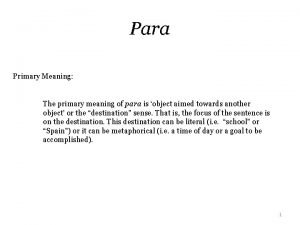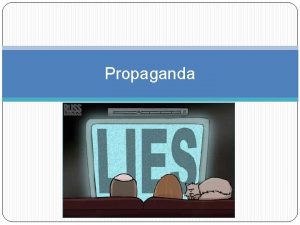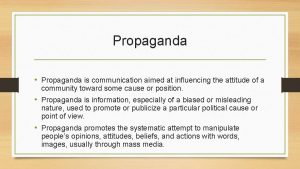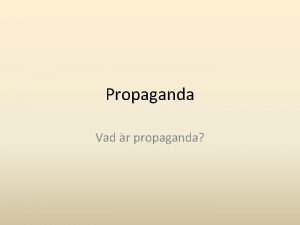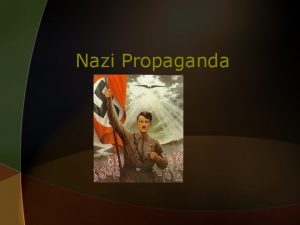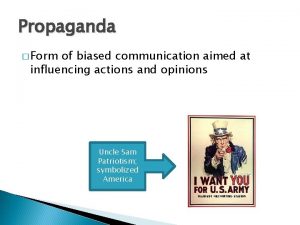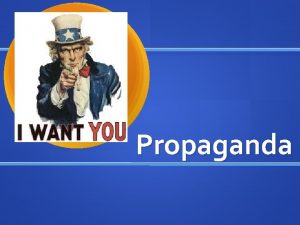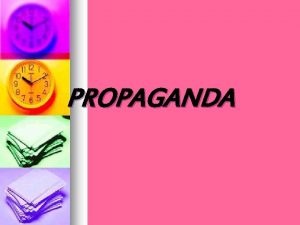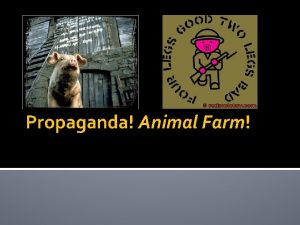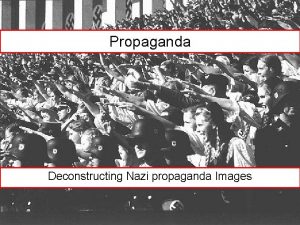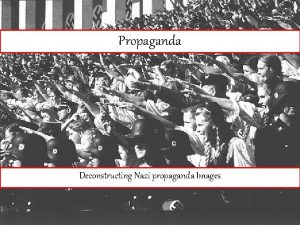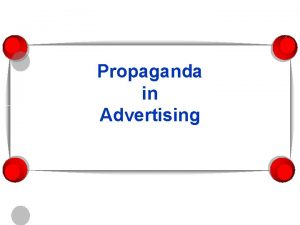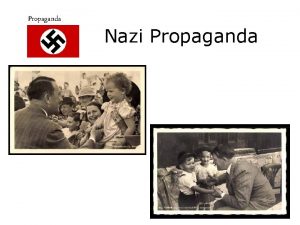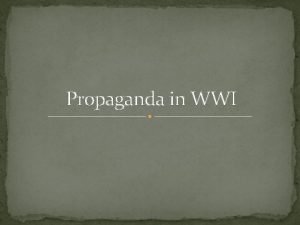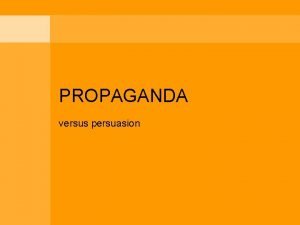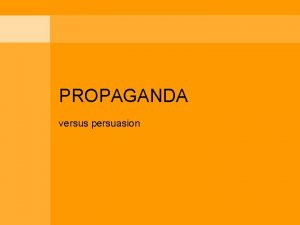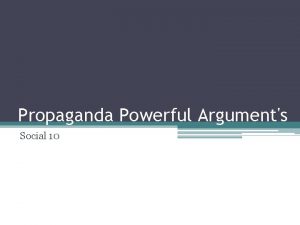Propaganda Propaganda Messages aimed at influencing the opinions
























- Slides: 24

Propaganda

Propaganda Messages aimed at influencing the opinions or behaviors of large numbers of people. Often presents facts selectively. Gives loaded messages in order to produce an emotional response.

Types of Propaganda can be seen in public information campaigns by governments, which are intended to encourage or discourage certain forms of behavior (such as wearing seat belts, not smoking, not littering and so forth). Propaganda can take the form of pamphlets, posters, radio, TV shows, etc. Propaganda is a powerful weapon in war; it is used to dehumanize and create hatred toward an “enemy”. This can be done by using hateful or racist terms or by blaming society’s problems on certain groups of people.

Propaganda Techniques Ad hominem: attacking your opponent, as opposed to attacking their arguments. Ad nauseam: Using repetition of an idea or a simple slogan; if it is repeated enough times, it may be taken as the truth. Ex: “Napoleon is always right. ” (Animal Farm) Appeal to authority: Using important people to support a position, idea, argument, or course of action. Ex: “Our leader, Comrade Napoleon…has stated categorically…that Snowball was Jones’ agent from the beginning. ” (Animal Farm) Appeal to fear: seeks to build support by creating fear and panic in the general population. Ex: “Do you know what would happen if we pigs failed in our duty [to eat the apples]? Jones would come back!” (AF)

Techniques (cont’d) Appeal to prejudice: Making people think that believing a certain idea is morally “good” and not believing it is morally “bad. ” Bandwagon: persuading people to join in and take the course of action that "everyone else is taking. ” Black-and-white fallacy: Presenting only two choices, with one idea being highlighted as the better choice. "You are either with us, or you are with the enemy") Ex: “Four legs good, two legs bad. ” (Animal Farm) Beautiful people: uses famous or attractive, happy people. This makes other people think that if they buy a product, they too will be happy or successful. (This is more used in advertising for products, instead of political reasons)

Techniques (cont’d) Big Lie: Descriptions of events that have elements of truth, but twist the “big picture. ” Eventually, this story replaces the real story. Demonizing the enemy: Making individuals from another nation, ethnic group, or those who support another viewpoint appear to be subhuman, worthless, or immoral (ex: false accusations and stereotyping) Direct Order: simplifies the decision-making process by using images and words to tell the audience exactly what to do. Ex: “That is my message to you, Comrades. Rebellion!” (AF) “Vote for me!”

Techniques (cont’d) Euphoria: the use of an event that generates happiness or boosts morale. Half-truth: deceptive statement which includes only some elements of truth. Ex: “The whole management and organization of this farm depend on us. ” (AF) Reductio ad Hitlerum: used to persuade people to disapprove of an action/idea by suggesting that the idea is only popular with hated or feared groups of people. Euphemism: use of “politically correct” terms as a means of softening an idea or claim. (e. g. instead of “He died, ” use “He passed away. ”)

Technique (cont’d) Scapegoating: Blaming an individual or group for society’s problems. Ex: “Do you know the enemy who has come at night and overthrown our windmill? SNOWBALL!” (AF) Slogans: A simple, brief, and striking phrase that may include labeling and stereotyping. Ex: “Just do it. ” or “I’m lovin’ it. ” Doublespeak: any language deliberately constructed to disguise or distort its actual meaning, often by using euphemism or unclear statements. (Saying “It’s not you, it’s me” instead of saying “I don’t like you anymore”)

Name that Technique! The next few slides will have examples of propaganda. Identify the technique of propaganda being used. PADEM Purpose Audience Design Emotion/Mood Message

Name that Technique!

“If you don’t want the old yoke back, join the ranks of the Communists. ”

Name that Technique!

Glory to Stalin – the Great Architect of Communism!

For the Socialist motherland, for the happy life, votes (having full rights) the Soviet woman!

Name that Technique!

Name that technique!

Name that technique!

Name that technique!

Name that technique!

“Comrade Lenin cleans the Earth of scum” November 1920

Name that Technique!

Name that technique!

Name that technique!

Name that technique!
 Example of secondary group
Example of secondary group Meaning
Meaning Johannes volkelt empathy theory advantages
Johannes volkelt empathy theory advantages Systematic inquiry aimed at the discovery of new knowledge
Systematic inquiry aimed at the discovery of new knowledge Conducting psychological research
Conducting psychological research Tư thế ngồi viết
Tư thế ngồi viết Thẻ vin
Thẻ vin Giọng cùng tên là
Giọng cùng tên là Chó sói
Chó sói Thể thơ truyền thống
Thể thơ truyền thống Sự nuôi và dạy con của hươu
Sự nuôi và dạy con của hươu Từ ngữ thể hiện lòng nhân hậu
Từ ngữ thể hiện lòng nhân hậu Thế nào là hệ số cao nhất
Thế nào là hệ số cao nhất Diễn thế sinh thái là
Diễn thế sinh thái là Vẽ hình chiếu vuông góc của vật thể sau
Vẽ hình chiếu vuông góc của vật thể sau Ng-html
Ng-html 101012 bằng
101012 bằng Lời thề hippocrates
Lời thề hippocrates Thang điểm glasgow
Thang điểm glasgow đại từ thay thế
đại từ thay thế Vẽ hình chiếu đứng bằng cạnh của vật thể
Vẽ hình chiếu đứng bằng cạnh của vật thể Quá trình desamine hóa có thể tạo ra
Quá trình desamine hóa có thể tạo ra Công thức tính thế năng
Công thức tính thế năng Thế nào là mạng điện lắp đặt kiểu nổi
Thế nào là mạng điện lắp đặt kiểu nổi Khi nào hổ con có thể sống độc lập
Khi nào hổ con có thể sống độc lập

